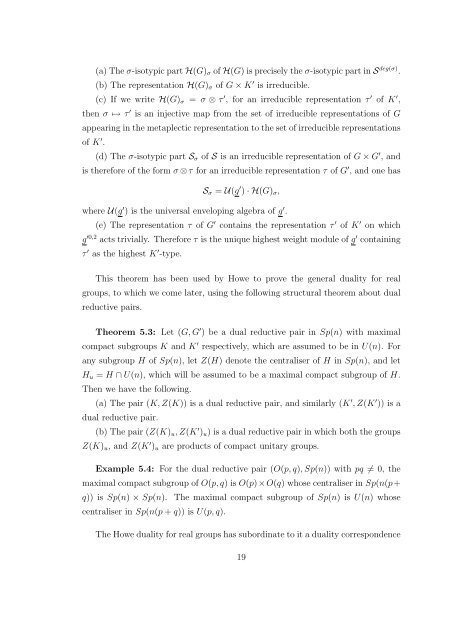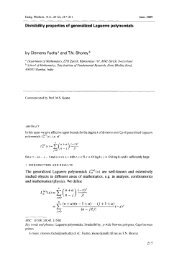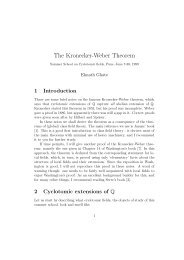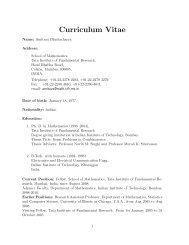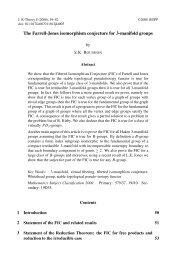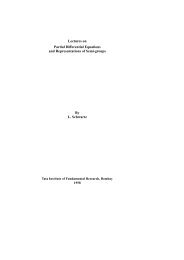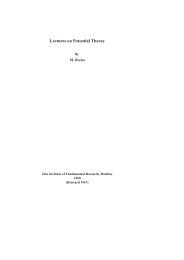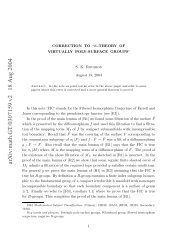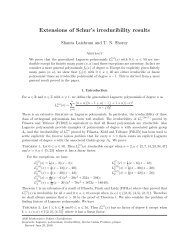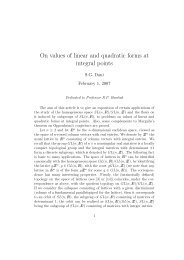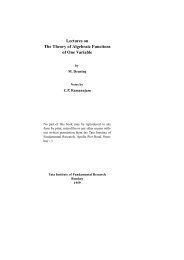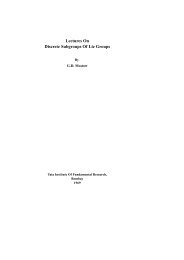Weil Representation, Howe Duality, and the Theta correspondence
Weil Representation, Howe Duality, and the Theta correspondence
Weil Representation, Howe Duality, and the Theta correspondence
You also want an ePaper? Increase the reach of your titles
YUMPU automatically turns print PDFs into web optimized ePapers that Google loves.
(a) The σ-isotypic part H(G) σ of H(G) is precisely <strong>the</strong> σ-isotypic part in S deg(σ) .(b) The representation H(G) σ of G × K ′ is irreducible.(c) If we write H(G) σ = σ ⊗ τ ′ , for an irreducible representation τ ′ of K ′ ,<strong>the</strong>n σ ↦→ τ ′ is an injective map from <strong>the</strong> set of irreducible representations of Gappearing in <strong>the</strong> metaplectic representation to <strong>the</strong> set of irreducible representationsof K ′ .(d) The σ-isotypic part S σ of S is an irreducible representation of G × G ′ , <strong>and</strong>is <strong>the</strong>refore of <strong>the</strong> form σ ⊗ τ for an irreducible representation τ of G ′ , <strong>and</strong> one hasS σ = U(g ′ ) · H(G) σ ,where U(g ′ ) is <strong>the</strong> universal enveloping algebra of g ′ .(e) The representation τ of G ′ contains <strong>the</strong> representation τ ′ of K ′ on whichg ′0,2 acts trivially. Therefore τ is <strong>the</strong> unique highest weight module of g ′ containingτ ′ as <strong>the</strong> highest K ′ -type.This <strong>the</strong>orem has been used by <strong>Howe</strong> to prove <strong>the</strong> general duality for realgroups, to which we come later, using <strong>the</strong> following structural <strong>the</strong>orem about dualreductive pairs.Theorem 5.3: Let (G, G ′ ) be a dual reductive pair in Sp(n) with maximalcompact subgroups K <strong>and</strong> K ′ respectively, which are assumed to be in U(n). Forany subgroup H of Sp(n), let Z(H) denote <strong>the</strong> centraliser of H in Sp(n), <strong>and</strong> letH u = H ∩ U(n), which will be assumed to be a maximal compact subgroup of H.Then we have <strong>the</strong> following.(a) The pair (K, Z(K)) is a dual reductive pair, <strong>and</strong> similarly (K ′ , Z(K ′ )) is adual reductive pair.(b) The pair (Z(K) u , Z(K ′ ) u ) is a dual reductive pair in which both <strong>the</strong> groupsZ(K) u , <strong>and</strong> Z(K ′ ) u are products of compact unitary groups.Example 5.4: For <strong>the</strong> dual reductive pair (O(p, q), Sp(n)) with pq ≠ 0, <strong>the</strong>maximal compact subgroup of O(p, q) is O(p)×O(q) whose centraliser in Sp(n(p+q)) is Sp(n) × Sp(n). The maximal compact subgroup of Sp(n) is U(n) whosecentraliser in Sp(n(p + q)) is U(p, q).The <strong>Howe</strong> duality for real groups has subordinate to it a duality <strong>correspondence</strong>19


